|
New Delhi, Sep 29 (IANS) Every month, an Indian soldier is injured or even dies, not at the hands of the enemy, but by his own ammunition that turns out to be faulty.
The ammunition is supplied by the state-run ordnance factories. According to government officials, the forces report an average of one ammunition-related accident every week, resulting in injuries or fatalities, and damage to equipment.
This run of accidents due to the poor quality ammunition from the Ordnance Factory Board-run facilities, the primary suppliers, has led to low levels of confidence among armed force personnel, particularly among the Indian Army, who use more ammunition than the Air Force or the Navy.
In 2020, a total of 13 armed personnel were injured due to faulty ammunition, while 16 accidents were reported in 2019, leaving 28 soldiers injured and three dead. In 2018, at least 43 soldiers were injured and three lost their lives in 78 incidents and in 2017, there were 53 incidents, causing the death of one soldier and injuries to 18 others.
It was, however, 2016 that was the worst, with 19 soldiers killed and 28 others injured in 60 accidents.
This has also led to a major loss to the exchequer. As per estimates, Rs 658.58 crore worth of ammunition had to be disposed off between April 2014 and April 2019, during its shelf life.
Sources also said that mines worth Rs 303.23 crore had to be disposed off, within their shelf life, post the Pulgaon accident in Maharashtra in May 2016 in which 18 soldiers were killed.
Sources also said that all this led to a Rs 960 crore loss, with which 100 155mm Medium Artillery guns could have been purchased.
It is obvious that defective ammunition has major implications for the soldiers using them, as accidents lead to loss of life, but also equipment being rendered out of action, resulting in lack of confidence in the equipment itself.
A senior government official said that this also has serious operational ramifications wherein requisite ammunition is not available to optimally utilise the capability of the equipment.
Further, it also leads to the need for re-inspections, back-loading, reissue and disposal by destruction of ammunition -- an exercise which is extremely time-consuming, expensive, dangerous and totally avoidable.
A top Indian Army officer said accidents have occurred primarily due to faulty ammunition, defective armament and faulty drills by the crew operating equipment or due to deficiencies in storage conditions, an issue of serious concern and one that is easily avoidable.
"While isolated accidents do occur even in modern armies the world over, the Indian Army is faced with a serious issue of regular accidents primarily due to defective ammunition," the officer said.
Regular accidents are occurring with the 105mm Indian Field Gun, the 105mm Light Field Gun, the 130mm MA1 Medium Gun, the 155mm Bofors (isolated cases), the 40mm L-70 Air Defence Guns and main guns of the T-72, T-90 and Arjun main battle tanks.
There have been 31 accidents since 1998 primarily due to defects in high explosive (HE) ammunition for the L-70 gun in which three soldiers have been killed and 95 personnel have been injured.
The last such accident occurred on February 2, 2019 at Mahajan Field Firing Range during the annual firing of the 104 Air Defence Regiment.
This accident involved ammunition of the 2015 lot, manufactured at Ordnance Factory at Khamria, resulting in serious injuries to five soldiers, including an officer.
All training firing of the L-70 HE ammunition has been stopped with effect from February 3, 2019, following this accident.
Thereafter, the Indian Army sought a meeting to be chaired by Secretary, Defence Production to address the problem areas and find a way ahead.
At the meeting, the main areas of concern regarding the ammunition supplied by the ordnance factories were listed and it was pointed out that the directions issued for the safety of soldiers handing the ammunition were yet to be implemented.
These directions had been issued by the Army vice chief in December 2017 at another meeting to take stock of accidents involving L-70 guns firing HE ammunition, officials said.
The safety measures pertained to validation of ammunition, introduction of improved ammunition, modernisation of production and processes, and fixing of blame for faulty ammunition.
Following the accident, the entire range of L-70 HE ammunition held by Indian Army is now suspected to be faulty.
A meeting called by the Director General, Army Air Defence on February 14, 2019 was of no avail as the OFB's representatives - the Senior General Manager of the Ordnance Factory at Khamaria and OFB's Member and Deputy Director General for Ammunition - failed to turn up.
According to an official, "problem solving by the ordnance factories is done in a piecemeal manner and not on a mission mode".
"Inputs from the OFB and the DGQA indicates that problem areas are still being addressed piecemeal, in that problems of cartridge input material, varying cartridge manufacture process at the two ordnance factories, propellant quality, TNT checks, primer/detonator filling and input material examination by CQA (Certified Quality Auditor) are not being addressed holistically," the official said.
Transfer of Technology issues were highlighted during various meeting involving accidents with L-70 guns, with sources saying it was noteworthy that production of ammunition continued in spite of concerns with the transfer of technology and accidents.
Further, there has been a failure in the on-going audits by the Ordnance Factory Board and the DG, Quality Assurance in terms of preventing accidents involving HE ammunition fired from L-70 guns, with allegations that both have failed in effective quality control and quality assurance since 1998.
Also, non-conformities were found during audits by the OFB and DG, Quality Assurance, and these need to be investigated by the Secretary, Defence Production.
Moreover, there is also no mechanism of sharing of non-conformities and action taken with the Indian Army's Master General Ordnance branch by the Department of Defence Production.
Officials also say that large quantities of ammunition supplied by the OFB to the Indian Army has been found to be defective during its shelf life.
The defects are mostly due to poor quality control and quality assurance and lack of modernisation of storage.
"Blackening of ammunition in respect of small arms and heavy calibre ammunition is a major cause of concern which is another evidence of poor metallurgy and packaging and needs to be addressed immediately," said an official.
Deficiency of repair components renders ammunition as not fit to be fired or used. This not only affects operational readiness adversely, but also leads to serious storage and safety issues, and contributes towards accidents.
With surprise checks conducted at the High Explosive Factory at Khadki and the Ordnance Factory at Chanda in 2017 and 2018, respectively, a number of shortcomings were highlighted but have not been rectified yet and the follow-up remain to be intimated by the Department of Defence Production or the OFB to the armed forces till date.
The inspection report was shared through Master General of Ordnance branch in a letter dated December 12, 2017, and the deficiencies highlighted to Assistant Secretary, Defence Production in February 2018.
The department's Additional Secretary chaired a meeting on February 23, 2018 and directed another surprise check in two months after confirmation of shortcomings having been resolved. This check is yet to be conducted.
The High Explosive Factory at Khadki has stopped manufacturing of TNT, a critical ingredient of ammunition, as communicated to the MGO during his visit to the Controller of Quality Assurance (Ammunition) at Pune on February 6, 2019.
Further, the Project Monitoring Group has got diluted at the level of various ordnance factories.
The OFB has said the delays were happening due to lack of cooperation by Central Institute of Plastic and Engineering Technology, but this claim was found to be incorrect, said officials.
It was highlighted to the Secretary, Defence Production during a meeting on January 16, 2019, wherein he directed the OFB to constitute a new committee to lay down fresh terms of reference and give a roadmap for aligning the OFB ammunition packaging with the best global practices.
"No progress has been made on the same," said the official, adding that the Return for Rectification of the OFB factories has reflected an above 20 per cent rejection rate, as against the NATO standard is of two per cent maximum.
Each instance of return for rectification or ammunition results in wastage of time, money and effort.
Poor quality assurance and quality control, an archaic infrastructure coupled with lack of accountability of the OFB and the DGQA are considered to be the major reasons for continuing accidents and defects with the ammunition.
A holistic analysis of the problems with the ammunition has to be carried out.
The OFB has a fixed client in the Indian Army, which is solely dependent on the state-run factories for its ammunition requirements, with total monopoly of the ammunition by the OFB. Resultantly, the OFB has the ability to get away with sub-standard products, officials said, adding that it must compete with global leaders in the ammunition industry and this competition could infuse some quality control and better performance.
In order to streamline the manufacturing processes and provide quality products, adequate absorption of Transfer of Technology is needed. Also, there is a need to ensure that all components of ammunition lot should have homogeneity, aligned with global standards.
During the past two decades, several High Level Committees like T.K.A. Nair Committee, the Vijay Kelkar Committee and the Raman Puri Committee have inter-alia recommended that Ordnance Factories should be converted from a government department into a corporate entity.
The government floated a proposal for corporatisation in July 2019 but the trade unions called for an indefinite strike against the decision on August 20, 2019. However, the strike was called off on August 26, 2019 after assurances by the Secretary, Defence Production that government has not taken any decision yet towards the OFB's corporatisation.
The government thereafter set up a committee to address the concerns of the employees in September 2019 and subsequently in November 2019, notified the "proposal to convert Ordnance Factories under the OFB into a 100 percent government owned public sector unit".
The biggest concerns of the OFB employees is that "Corporatisation" is the first step towards "Privatisation" and is likely to result in layoffs and job cuts. However, as of now, the government has made it very clear that it is not thinking of privatisation in the near future and the OFB will function akin to the various PSUs in the country post corporatisation.
(Sumit Kumar Singh can be reached at sumit.k@ians.in)
--IANS
sk/in/vd
Copyright and Disclaimer: All news and images appearing in our news section, search engines and social media are provided by IANS. If you face any issues related to the content/images, please contact our news service provider directly. We are not liable/responsible for any content/images related to the news service provider.
|








